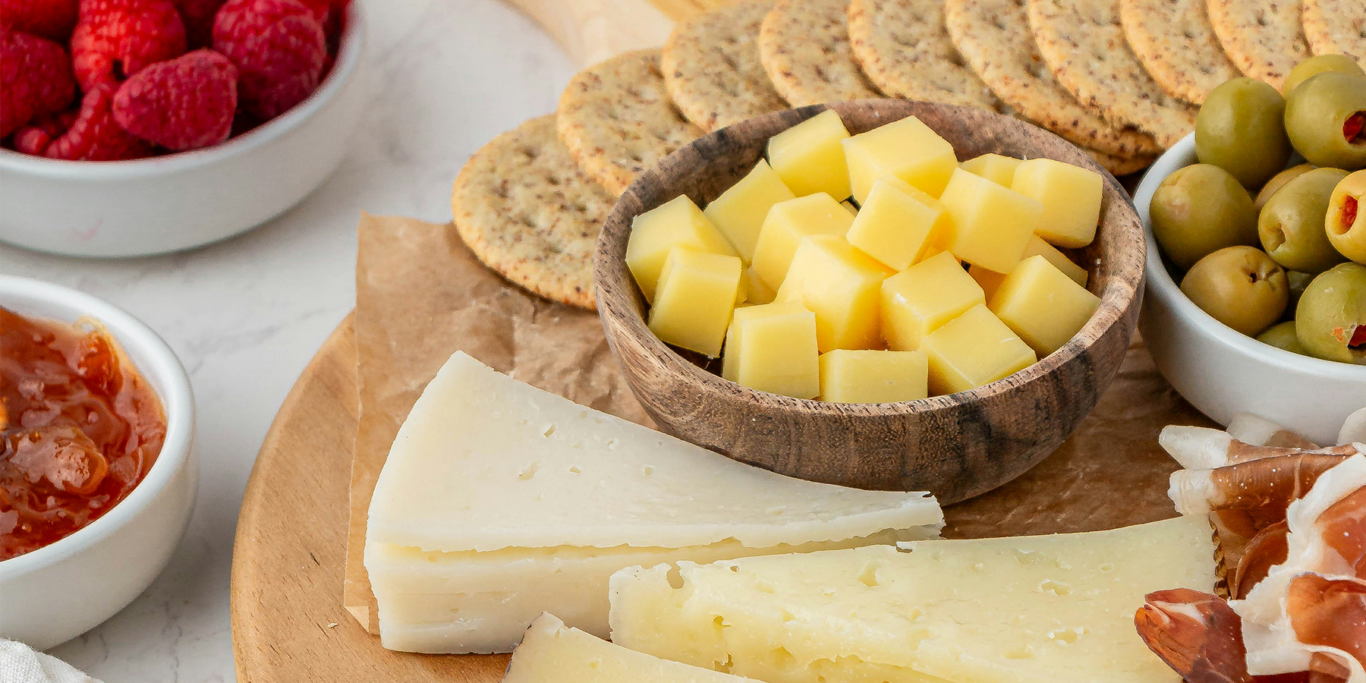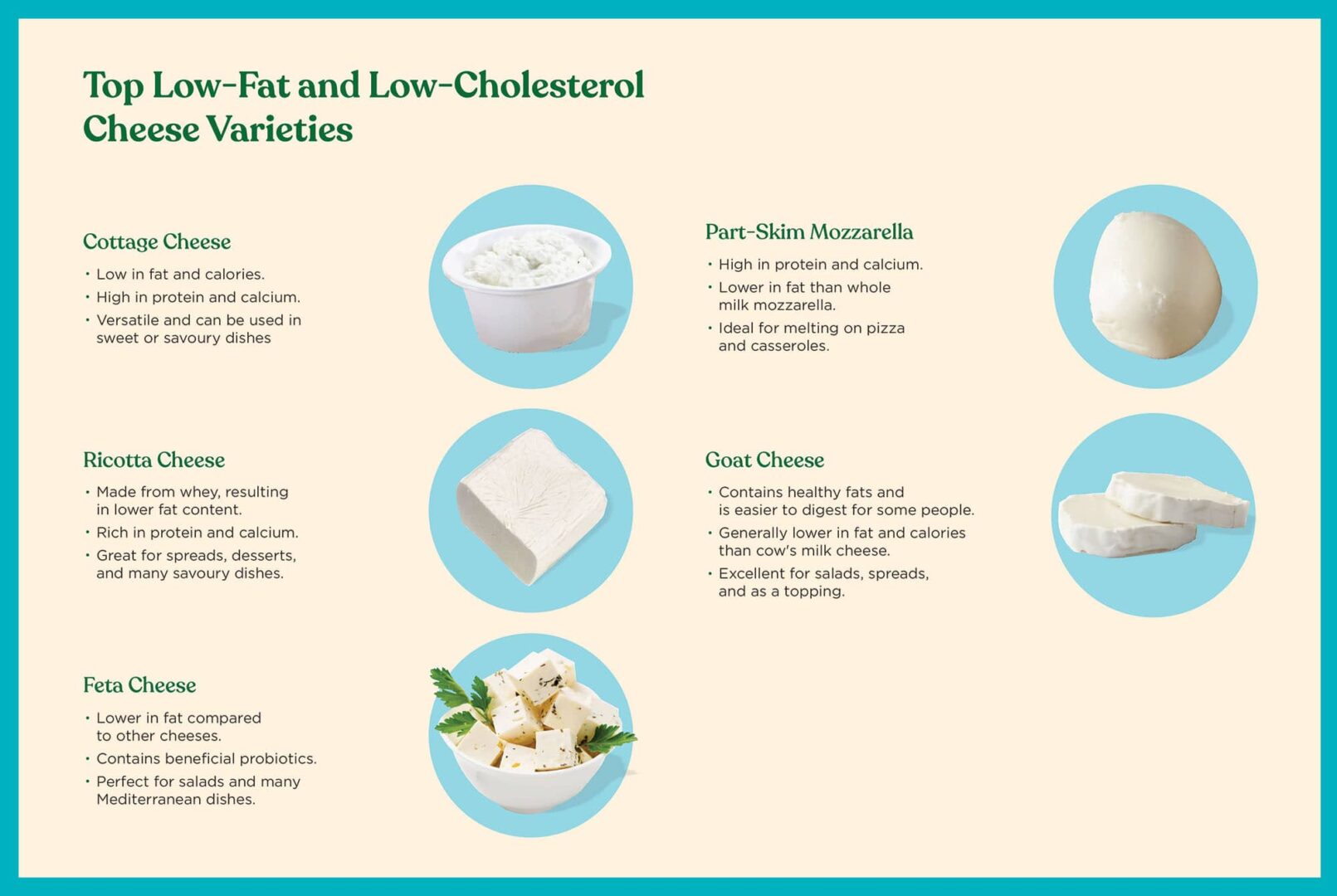Can cheese fit into a cholesterol friendly diet?
Cheese lovers, rejoice! If you’re trying to manage your cholesterol, you might think you need to bid farewell to your favourite cheesy treats. But the good news is, with a bit of knowledge and smart choices, cheese can still be part of your heart-healthy diet. Let’s explore how cheese can fit into a cholesterol-friendly diet and discover the best options to keep your heart happy and healthy.

Understanding Cheese and Cholesterol
How well do you know the levels of saturated fats in foods? Test your knowledge with our Healthy Heart Habits quiz!
The Relationship Between Cheese and Cholesterol
Cheese is a beloved staple in many diets around the world, offering a delicious source of calcium, protein, and other essential nutrients. However, it’s also known for its saturated fat and cholesterol content, which can raise LDL (low-density lipoprotein) cholesterol levels—the kind that contributes to plaque buildup in the arteries and increases the risk of heart disease. It is also high in salt which should be kept to a minimum to promote heart health.
Benefits of Cheese
Cheeses can be a great addition to the diet. They’re packed full of nutrients, including calcium, iodine, potassium, and are a good source of animal protein including the amino acids our body can’t make. In addition to this, the majority of cheese is fermented, which means there is something special about the food structure, as with other fermented foods like yoghurt, that means, despite having a high saturated fat content, the evidence suggests they may not impact our cholesterol in the same negative way that high-fat non-fermented dairy foods like butter do. Many cheeses contain healthy micro-organisms that we know from clinical trials are good for the immune system. We still don’t understand the full extent of the benefits of these microbes in cheese but it’s safe to say that eaten in moderation, cheese can absolutely be enjoyed as part of a healthy cholesterol-lowering diet.
Not all cheese is created equal
Cheese is a very diverse sub-category of dairy food, and differs according to whether it’s whether it’s hard or soft, and according to the fat content. Some varieties of cheese are lower in fat, making them better choices for those managing their cholesterol levels. It’s also possible to be mindful of portion size in order to still enjoy cheese whilst limiting the total quantity so there is a healthy balance in the diet. By understanding the nutritional profile of different cheeses and making informed choices, you can enjoy cheese while keeping your cholesterol in check.
What Cheese is Low in Fat and Cholesterol?
Criteria for Low-Fat Cheeses
When selecting cheese for a cholesterol-friendly diet, consider the following criteria:
- Low Saturated Fat: Opt for cheeses with lower saturated fat content (see below).
- Portion Control: Be mindful of serving sizes to avoid overconsumption. Stick to one to two servings of cheese per day (one serving is about a small matchbox-sized piece or 30 grams).
Read More: Is Yogurt Bad for Cholesterol?
Top Low-Fat Cheese Varieties
1. Cottage Cheese
- Low in fat and calories.
- High in protein and calcium.
- Versatile and can be used in sweet or savoury dishes.
2. Ricotta Cheese
- Made from whey, resulting in lower fat content.
- Rich in protein and calcium.
- Great for spreads, desserts, and savoury dishes.
3. Feta Cheese
- Lower in fat compared to many other cheeses.
- Contains beneficial probiotics.
- Perfect for salads and Mediterranean dishes.
4. Part-Skim Mozzarella
- Lower in fat than whole milk mozzarella.
- High in protein and calcium.
- Ideal for melting on pizzas and in casseroles.
5. Goat Cheese
- Generally lower in fat and calories than cow’s milk cheese.
- Contains healthy fats and is easier to digest for some people.
- Excellent for salads, spreads, and as a topping.
Read More: Healthy Foods to Lower Cholesterol
Plant-Based Cheeses: Better for Cholesterol Levels?
In recent years, the variety and taste of plant-based cheeses have significantly improved. Options like almond cheese, cashew cheese, and soy cheese are now readily available in many supermarkets. These alternatives are sometimes lower in fat and also cater to those with lactose intolerance or dairy allergies.
Differences Between Traditional and Plant-Based Cheeses
Plant-based cheeses are made from ingredients like nuts, soy, and coconut oil instead of dairy. Some of these cheeses may be lower in saturated fat, making them an option for those looking to manage their cholesterol levels.
Nutritional Considerations of Plant-Based Cheeses
Plant-based cheeses have a very different nutritional profile to traditional dairy cheese. For instance, nut-based cheeses may be rich in healthy fats, vitamins, and minerals, but very few are fortified with calcium, vitamin B12 or vitamin D. Look out for coconut oil-based options which may be high in saturated fat and so should be avoided as part of a cholesterol-lowering diet. Plant-based cheese on the whole are lower in protein and calcium than traditional dairy cheese, and salt content can vary. Opt for low-saturated fat and low-salt options where possible.

Photo by Diana Light on Unsplash
How Much Cheese to Eat Per Day Without Affecting Cholesterol Levels?
General Dietary Guidelines
Moderation is key when it comes to incorporating cheese into a cholesterol-friendly diet. Here are some guidelines to follow:
- Portion Size: Stick to one to two servings of cheese per day (one serving is about 1.5 ounces or 40 grams).
- Balance: Pair cheese with high-fibre foods like vegetables, fruits, and whole grains to help manage cholesterol levels.
Factors Influencing Cheese Consumption
- Overall Diet: Ensure your overall diet is balanced and rich in fruits, vegetables, lean proteins, and whole grains.
- Individual Health Needs: Consult with a healthcare professional to determine the best dietary plan for your specific health needs.
Is Feta Cheese Good for Cholesterol?
Nutritional Profile of Feta Cheese
Feta cheese is a popular choice for those looking to manage their cholesterol levels. It’s lower in fat compared to many other cheeses and provides beneficial nutrients like calcium and protein.
Benefits of Feta Cheese
- Fermented: Supports gut health.
- Lower Fat cheese option: Helps in managing overall saturated fat intake.
- Versatile: Can be used in various dishes, and packs a punch so can add flavour without using excessive amounts – a little goes a long way.
How to Include Feta Cheese in Your Diet
- Salads: Crumble feta over salads for a tangy flavour boost.
- Grains: Add feta to whole grain dishes like quinoa or bulgur.
- Snacks: Pair with fruits like watermelon or berries for a refreshing snack.
Is Mozzarella Cheese High in Cholesterol?
Fat Content of Mozzarella Cheese
Mozzarella cheese, particularly the part-skim variety, is lower in fat and cholesterol than many other cheeses. This makes it a good option for those watching their cholesterol levels.
Health Benefits and Considerations
Mozzarella is rich in calcium and protein, and it melts beautifully, making it a versatile addition to many dishes. However, moderation is key, and opting for part-skim versions can help keep saturated fat intake in check.
Tips for Enjoying Mozzarella
- Caprese Salad: Combine mozzarella with tomatoes, basil, and a good drizzle of olive oil for a healthy, delicious salad.
- Pizza: Use part-skim mozzarella to make a homemade pizza with a whole grain crust and plenty of vegetables.
- Sandwiches: Add slices of mozzarella to sandwiches with lean meats and lots of veggies.
Is Cottage Cheese High in Cholesterol?
Understanding the Fat Content in Cottage Cheese
Cottage cheese is a good option for a cholesterol-friendly diet. It’s naturally lower in fat than other cheeses, while being high in protein and other essential nutrients.
Health Benefits of Cottage Cheese
Cottage cheese supports muscle health due to its high protein content and can be enjoyed in a variety of ways—sweet or savoury. It’s an excellent option for those looking to have a more heart-healthy cheese option.
Delicious Ways to Enjoy Cottage Cheese
- Breakfast Bowl: Top cottage cheese with fresh fruits and a sprinkle of nuts for a nutritious breakfast.
- Smoothies: Blend cottage cheese into smoothies for an extra protein boost.
- Savoury Dishes: Use cottage cheese in place of hard cheeses in lasagna or stuffed pasta dishes.
Read More: Healthy Tips
Conclusion: Enjoying Cheese the Heart-Healthy Way
We believe that a heart-healthy diet can still include your favourite foods, including cheese. By making smart choices and opting for low-fat varieties and managing portions, you can enjoy the creamy, delicious taste of cheese while keeping your heart in mind. Remember, moderation is key, and balancing your diet with a variety of nutritious foods will help you maintain a healthy lifestyle.
Ready to explore more ways to eat well and keep your cholesterol in check? Check out our Healthy Tips category for more delicious and heart-friendly advice. And don’t forget to read our article on Keeping Your Cholesterol on Track During the Holidays for more insights!
Resources:
British Heart Foundation: 7 cheese facts that will surprise you
British Heart Foundation: Cheese: the good, the bad and the ugly

